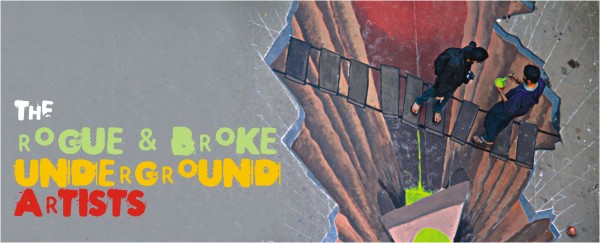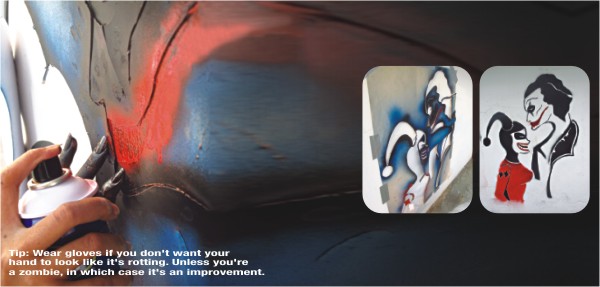
Bangladesh is home to a magnificent community of renowned artists, whose works have been lauded by critiques and connoisseurs of art from all over the world. However, it should come as no surprise that they are not alone in their field of passion. The almost unheard-of communities devoted to upholding independent ('indie') and avant-garde forms of art are a testament to this fact, and these communities are steadily growing. And upon taking a closer look at these groups, it becomes even clearer that art is not something that can simply be constrained by little things such as definitions.
One of the groups that have recently come to receive a considerable degree of public attention is Bangladeshi Deviant, a community of Bangladeshi artists on the global online art forum deviantART. Although the members of the movement are all Bangladeshi, they are quite a scattered bunch in terms of geography, united by their love for art, music, video games and food. They welcome every form of art, including debatable forms of it such as memetic mutations and merciless trolling. While the community's online gallery can only contain artworks on (literal or digital) canvases, photographs and pieces of literature, they have been known to go far wilder in person, incorporating aspects of art such as innovative live musical performances, interactive art and light painting. Recently, the Bangladeshi Deviants rolled out their very first public exposition, Untitled-1, in an attempt to jumpstart the indie art movement in Bangladesh and to break free of the photography-centric pattern of modern exhibitions. The group, located at www.bangladeshi-deviant.deviantart.com welcomes everyone with a taste for art to join and contribute their works. They can also be found on Facebook at www.facebook.com/ bangladeshideviant.
 Another warm and welcoming name in the field of Bangladeshi indie art is the School of Everything Else (SEE). They are especially known for pulling off the Street Art Festival recently that covered 3D art and graffiti instalments. Anyone and everyone can be a part of it, as long as the one and only requirement - that of sharing one's own knowledge, ideas, inspirations, perspectives, thoughts, questions, skills and abilities with everyone else in any way possible - is fulfilled. SEE is interested in all that is present in the realms of art and science, and anything that appears beyond these fields. SEE believes that every individual is a repository of knowledge, unique ideas and perspectives, and by valuing that uniqueness and sharing it regardless of its extent or depth, SEE provides a platform to harvest and combine ideas that can be beneficial to everyone. Knowledge, combined and tested, is the most powerful force of all, and by properly using said knowledge, SEE intends to become a bigger and broader community that is equipped to reach for the stars and beyond with their marvellous imagination. SEE can be found on Facebook at www.facebook.com/ groups/ SchoolofEverthingElse.
Another warm and welcoming name in the field of Bangladeshi indie art is the School of Everything Else (SEE). They are especially known for pulling off the Street Art Festival recently that covered 3D art and graffiti instalments. Anyone and everyone can be a part of it, as long as the one and only requirement - that of sharing one's own knowledge, ideas, inspirations, perspectives, thoughts, questions, skills and abilities with everyone else in any way possible - is fulfilled. SEE is interested in all that is present in the realms of art and science, and anything that appears beyond these fields. SEE believes that every individual is a repository of knowledge, unique ideas and perspectives, and by valuing that uniqueness and sharing it regardless of its extent or depth, SEE provides a platform to harvest and combine ideas that can be beneficial to everyone. Knowledge, combined and tested, is the most powerful force of all, and by properly using said knowledge, SEE intends to become a bigger and broader community that is equipped to reach for the stars and beyond with their marvellous imagination. SEE can be found on Facebook at www.facebook.com/ groups/ SchoolofEverthingElse.
Another community that merits being mentioned here is GRAFA (Graphics and Animation Association), a web-based community of artists focused on uniting the digital artists of Bangladesh in order to share knowledge and expertise among themselves, and promote the computer graphics and animation industry in Bangladesh. GRAFA intends to build a forum of talented digital artists and provide them with a platform where they can express themselves through their works, educating and inspiring likeminded individuals. GRAFA organises workshops, more information on which can be found on their website at www. grafaonline.org.
There are numerous other indie art movements out there in Bangladesh, and thanks to the internet, they are but a few Google searches away. If you're into art, find a crew that suits your tolerance levels and tastes, and settle down with them. Their relative obscurity in comparison to mainstream art movements comes as a blessing rather than a curse, as these talented young men and women are not afraid to venture into uncharted waters and explore new and spectacular fields of art that forever tend to elude the artists who are chained by conventions. These young trailblazers have a great deal to offer - and you can be one of them too.

DIY: Cut, paste, spray
By Anashua
Stencils have been used for ages in Bangladesh, but only to post notices on walls or to mark houses. It can be seen in its very rough form, as letters cut out of cardboard and painted on with a brush, advertising to-lets. Only recently has stencilled street art been spotted in the city.
You don't need too many materials to make a stencil. Head off to the paint shops in Gawsia to buy good cans of spray paint, sheets of cardboard, masking tape and a sharp paper cutter. Glue isn't a necessity but it can be used to correct mistakes and smooth the edges of the cut out.
Some people choose to print out images, paste them on the cardboard and then cut along the lines, but others draw them by hand and then cut out the shape. Printing the image is easier for those who cannot draw. Stickers can also be bought from car shops which can be sprayed on. After the shapes have been cut out, do not go straight to stencilling because they might come out surprisingly different from what you expected. Test it out on spare paper first. The edges can be straightened out by lining with glue.
When you think your stencil has been perfected, you will come to a realisation that will frustrate you immensely. There are no clean walls in Dhaka. For miles around, every piece of wall has been covered with inanities like 'MM1' or 'Cool Boyzz' or 'Loove u teddy bear'.
If luckily you find a clean wall, freshly painted, very inviting, then wait till night before you stencil on it.
Take a companion, some duct tape, the cardboard and a torch. Tape the cardboard to the wall and spray on it to make an imprint of your stencil. Spraying from too close will make the paint drip, and spraying from far will give a blurry effect. Double spray on the minute details to make sure they come out. If you want to use many colours, cover parts of the stencil to prevent overlapping, and give it some time to dry. Don't expect to become Banksy in a day.
Finally, when you are creating a stencil, remember that point of street art is to be creative and to deliver a message. There is a difference between vandalism and art, so do not stencil something ugly. You would hate it if someone painted a giant butt on the side of your building, so do not go and do it to someone else.
